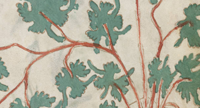origins
The Chestnut culture originated in the Northwest Peninsula of Tays. They are named, clearly, after their staple food: the Taysian chestnut (Castanea domestica). Pre-Chestnut cultures were predominantly gatherer-fishers, with a great deal of reverence for the chestnut tree. Eventually, this reverence led to the intentional moving and planting of trees to new areas. Over time, this system evolved into true agriculture. The Chestnut agricultural package - dominated by many varieties of chestnut, berries, roots, and oilseeds, spread throughout the peninsula rapidly. Domestic animals besides dogs were unknown, however, until introduced by southern traders. Chickens and pigs were readily adopted, and now form a significant part of Chestnut agriculture, but other animals have not been so quickly or widely accepted.
town planning and growth
Chestnut towns are extensively planned. Typically, a large town will scout a location for a new town three to seven years before the town itself is built. An ideal location is within a day’s walk of the originator town. Once a location has been established, a ring of young chestnut trees are planted. Additionally, older children are taken to the new town’s site, and perform a blessing ceremony. Ideally, a number of these children will become the first residents of the new town once it has been built. After the tree-planting and the blessing ceremony, a single house will be built in the center of the chestnut ring. This house will host a shaman, possibly with their family, who will maintain the chestnut ring for the first year.
The first anniversary of the tree-planting is celebrated similar to the first; a blessing delivered by the children, and berry bushes are planted amongst the saplings. The shaman’s house is ritually destroyed, and rebuilt larger, to accommodate another family or three. At this point, more chestnuts are planted sporadically, often in semi-circles within and outside of the initial chestnut ring, with an opening pointing towards the center.
After about 5 years, the first planted chestnuts are steady producers. The children who blessed the town site, at this point, are young adults - around 16 to 22 - and most will begin to move to the town. The town is now mbyat - “blooming” and ready for further growth. After another 5 to 10 years without significant incident, the town will likely have increased in population and size, and will enter the nò - “ready for picking” - stage. At this point, younger members of the community may move away to live with their spouse or with distant relatives, although the total population will still grow for a few more years.
Eventually, the initial settlers will pass away. At this point, the town will be considered gho - “fallow” - and will be slowly but deliberately abandoned. Depending on the age of the population, they may either start a new town, or move to stay with relatives for the last few years of their lives. The buildings of the town are typically dismantled, although not always. The trees and other crops, though, are left untouched. They may provide a base, a starting seed, for another settlement in a few decades, or they may naturalize and become a wild, although suspiciously neat, grove.
foodways
The staple food is, naturally, chestnuts. In some communities, chestnuts comprise up to 60% of all caloric intake, although the average is closer to 30-45%. There are over 60 recognized varieties of chestnut, varying slightly in flavor, size, plant hardiness, and more. Chestnuts are prepared in countless ways - the most standard being roasted and milled into flour. The chestnut flour (ngát) can be prepared into many kinds of flatbread, mixed with water and spices and slowly heated to form a kind of thick soup or sauce (known as syi), formed into small balls and boiled as dumplings (tųk), or mixed with pureed fruit and fried (phò).
Beyond chestnuts, a wide variety of fruits and vegetables are grown. The most culturally important are the pyatsík - the large bushes which produce a wide range of berries. Certain varieties of chestnut tree are planted specifically for wild animals. These trees typically grow shorter, and produce very small chestnuts (known as mbusyik). These trees pull double duty as bait and as a diversion from the main crops; the animals that eat the mbusyik are often trapped or shot and used as food.
As mentioned earlier, many communities have adopted chickens and pigs from foreign trade. Chestnut breed pigs are much smaller on average compared to pigs from the rest of Tays, often not surpassing 200lbs or getting longer than 4 feet. They are often bred specifically for truffle hunting or companionship, but they do provide a significant source of meat. Chickens are primarily raised for eggs, although occasionally a chicken will be slaughtered for food.
